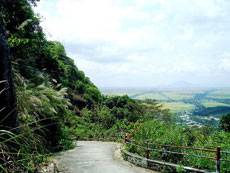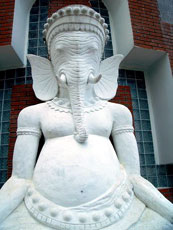Driving about 35 kilometers from Long Xuyen City to the west, tourists will arrive at Ba The Mountain, also known as Vong The (wait for one's wife). This mountain is located in Oc Eo Town, Thoai Son District, An Giang Province, in the Mekong River Delta region of Vietnam. This place is a vast ancient vestige of the Kingdom of Funan, a powerful nation in the Southeast Asia about two thousand years ago.
 There’s a winding concrete road to the top of the mountain. In 2002, this road was built by the government to serve tourism. At the top of Ba The Mountain is an ancient pagoda named Son Tien Tu which was built in 1933. Standing impressively in front of the pagoda is an 8-meter high statue of Bodhisattva Kwan Yin. Here, clouds bring cool dew that flies slowly through the sky. Trees stretch green as far as the eye can see and birds sing everywhere. People are dazed by the pagoda’s bell that periodically rings vibrantly over the forest. Next to the tower besides the ancient pagoda is a memorial stele which records the glorious feat of arms of Ba The - Thoai Son liberation troops destroying enemy bases on the top of the mountain on May 6, 1968.
There’s a winding concrete road to the top of the mountain. In 2002, this road was built by the government to serve tourism. At the top of Ba The Mountain is an ancient pagoda named Son Tien Tu which was built in 1933. Standing impressively in front of the pagoda is an 8-meter high statue of Bodhisattva Kwan Yin. Here, clouds bring cool dew that flies slowly through the sky. Trees stretch green as far as the eye can see and birds sing everywhere. People are dazed by the pagoda’s bell that periodically rings vibrantly over the forest. Next to the tower besides the ancient pagoda is a memorial stele which records the glorious feat of arms of Ba The - Thoai Son liberation troops destroying enemy bases on the top of the mountain on May 6, 1968.
Beside Son Tien Tu is a 3-meter high granite stone with a diameter large enough for four or five people to surround. On this huge stone’s surface is a footprint which is bigger than a normal human footprint. People call it a ban chan tien, or a fairy’s foot. This originated from a legend that at the beginning of the mountain, stones were soft like clay and a fairy pressed his foot to make this mark.
About ten meters from Son Tien Tu is a strange-looking house with a front door facing the direction of the rising sun, following the Hindu pattern and containing many antiques related to the history and culture of Ba The-Oc Eo.
Architecturally, this house looks like a lot of the temples found in South Asian countries with its dome and its rectangular door. The walls of the house are lined with statues of Ganesa deities with elephant heads on human bodies sitting majestically. The banisters are decorated with many small statues of a kind of Arabian horse.
 Ba The is where Oc Eo culture had the most development with thousands of antiques excavated such as jewelries made from pottery, stone, gold and bronze and many stone statues influenced by Buddhism and Hinduism such as statues of the Buddha, sacred objects of Yoni and Linga and an impressive group of Ganesa statues.
Ba The is where Oc Eo culture had the most development with thousands of antiques excavated such as jewelries made from pottery, stone, gold and bronze and many stone statues influenced by Buddhism and Hinduism such as statues of the Buddha, sacred objects of Yoni and Linga and an impressive group of Ganesa statues.
Oc Eo might have been a busy port of the kingdom of Funan between the 1st and 7th centuries A.D. Scholars use the term "Oc Eo Culture" to refer to the ancient material culture of the Mekong Delta region that is typified by the artifacts recovered at Oc Eo through archeological investigation. In this period, the ancient citadel of Oc-Eo used to be an active commercial center.
The relics of this culture give an insight into the lifestyles and attitudes of local people at that time, and also provide information about the history of the ancient Southeast Asian peoples, who had links with Oc Eo Culture.
These antiques have unveiled a secret curtain that hung over a strong and prosperous kingdom that originated in Southeast Asia. After about 1,500 years of the displacement of nature and history, this culture, day by day, has fallen into oblivion.
First excavated in the 1940s by French archaeologist Louis Malleret had unearthed many valuable artifacts, significantly, the evidence of a large seaborne trade involving Oc Eo and countries as far as Persia and the Roman Empire.
The study of Oc Eo Culture which Malleret instigated halted during the French and American wars and then restarted following reunification in 1975. Hundreds of excavations kicked off from Dong Nai to Kien Giang, resulting in the discovery of tens of thousands of valuable objects, of diverse origins and materials.
Oc Eo Ancient Citadel was rediscovered when the soil was dug out to build the Ba The Channel. The site has an area of 4,500ha still hold many mysteries to researchers and archaeologists.
Since 1975 many more excavations have been carried out in neighboring provinces of southern Viet Nam, revealing thousands more valuable relics of the Oc Eo - Funan civilisation. Many of the Oc Eo remains have been collected and are now on display in the Ho Chi Minh City Museum, the Viet Nam History Museum and a number of provincial museums in the Mekong Delta.
Ba The - Oc Eo is known as a famous historical and archaeological site. Nowadays, this site not only receives many researchers and archeologists who come to study and investigate but also attracts many local and foreign tourists who come to visit and study about a booming era of the former An Giang.
Phuong Anh (Collected)